Family : Orchidaceae

Text © Prof. Pietro Pavone

English translation by Mario Beltramini
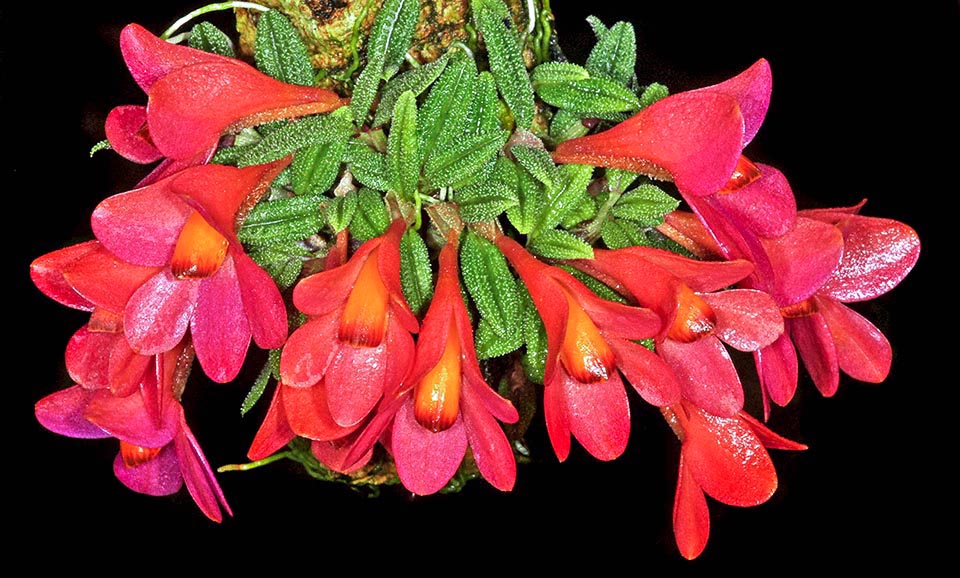
Dendrobium cuthbertsonii grows in the mountain highlands of New Guinea on the branches of Nothofagus and trunks of tree ferns, at times on thick cushions of moss. The persistent leaves are often warty in the upper pagina and the flowers are big, with labellum facing upwards, usually red, but also of other colours © Ron Parsons
Dendrobium cuthbertsonii F.Muell. (1888) is a species of the family Orchidaceae, subfamily Epidendroideae, tribe Malaxideae, subtribe Dendrobiinae, section Calyptrochilus.
In the past, this species has been included in the section Oxyglossum but recent studies made by botanists of the Hortus Botanicus of Leiden suggest to include it in the section Calyptrochilus due to its resemblance, but with shorter stems, with the species present in this section.
This species was discovered, during an expedition, in 1887 in New Guinea wanted by Sir Ferdinand Heinrich von Mueller (1825-1896), director of the Royal Botanic Gardens of Melbourne (Australia), and organized by the Royal Geographical Society of Australasia.
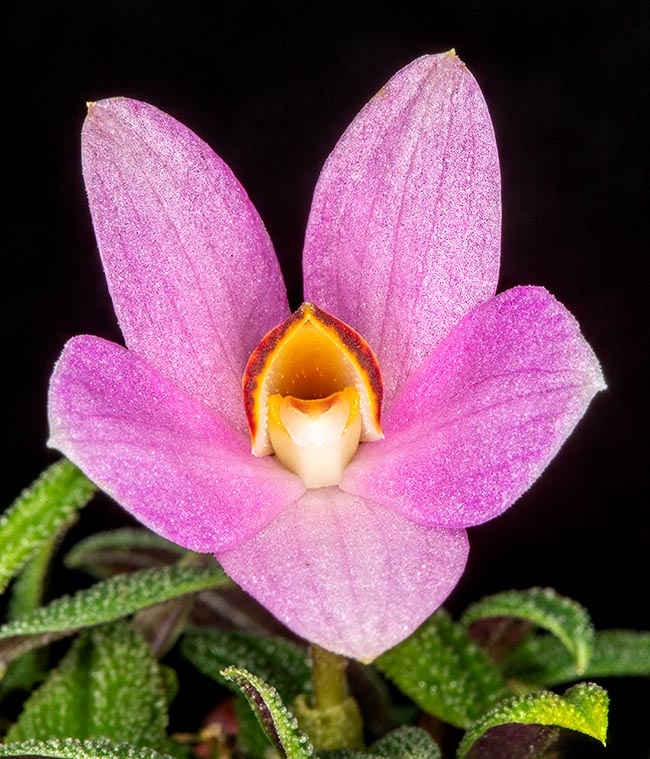
Colours of flowers vary from intense to pale red, from intense violet to fluorescent orange, from yellow to pure white © Giuseppe Mazza
To this expedition, besides the naturalist and collector WA Sayer, did participate the collector Walter Robert Cuthbertson in the quality of official responsible for the expedition.
From July to October of 1887 the two men have visited various sites such as Thursday Island and the eastern part of the island of New Guinea (Papua New Guinea) from Port Moresby and along the coast up to Mount Obree (2.325 m) on whose slopes have been collected specimens of this species that Mueller described in Transactions and Proceedings of the Royal Society of Victoria (Australia) 24:175 (1888).
Dendrobium cuthbertsonii, present in the Bismarck Archipelago and in the whole island of New Guinea, grows on the trees, in the mountain forests, mre rarely on the rocks, at an altitude of 750-3000 metres.
The name of the genus is the combination of the Greek substantives “δένδρον” (dendron), tree and “βίος” (bios), life, due to the numerous species of the genus living on the trees getting their nourishment from the humid atmosphere, typical to the equatorial forests.
The specific epithet is honoured to Cuthbertson who found it together with Sayer.
Common name: Dendrobium of Cuthbertson, The pumpkin pie orchid.
Dendrobium cuthbertsonii is an epiphytic species, occasionally terrestrial or lithophyte, grows on shrubs, tree ferns, borders and ridges of mossy forests of Nothofagus, on mossy rocks of streams, rocky walls more or less exposed to the breezes.
It is 2-8 cm tall, usually shaped like pulvini, with a diameter of up to 12 cm, at times with free more or less ramified stems, prostrate or ascending. The roots are white, from pinkish to violaceous when wet, and have a diameter of 0,5-1,5 mm and take form from a short rhizome that is longer if growing on moss and in shade.
The pseudobulbs measure 0,5-8(-14) x 0,1-0,7 cm and are spheroidal, ovoidal or club-shaped, but at times they are similar to stems and shortly ramified. The stems are 0,6 to 2,5 cm long with 2-4 nodes, more in the forms with long stems.
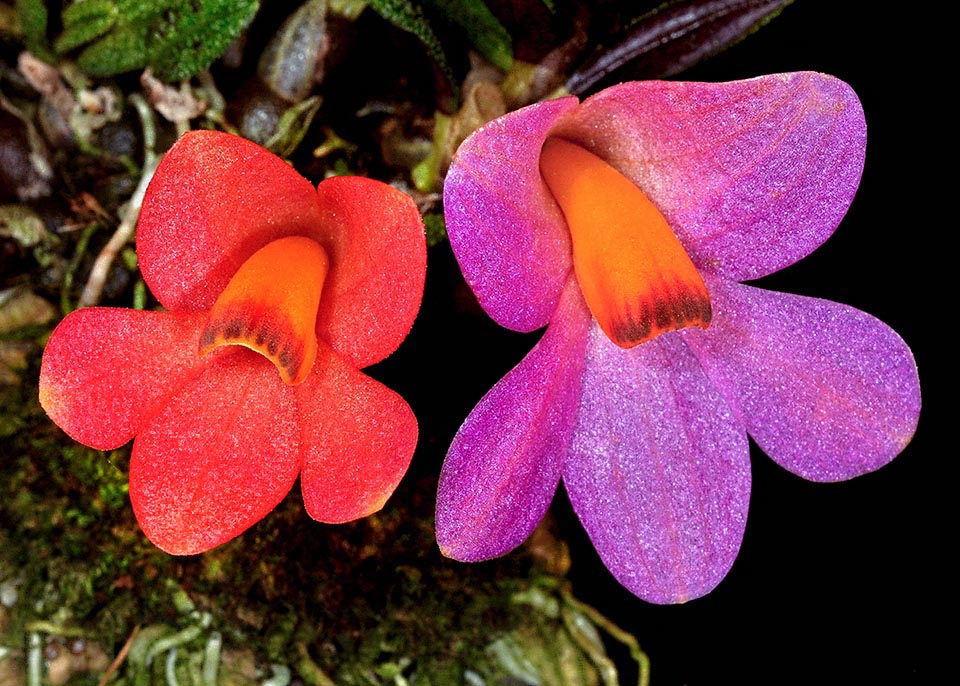
The absence of nectar has produced flowers with various colours that imitate, deceiving the pollinators, those of the nectariferous species growing close © Ron Parsons
The leaves, persistent, are in a number of 2-5, usually in the terminal part, but sometimes they can be numerous along the elongated stems. They measure 0,5 to 4,2 cm, whose shape varies from Linear to widely elliptic or ovate, with short petiole, often dilated at the base, or absent. The upper pagina, of green colour, sometimes blackish, can be glabrous or densely warty or papillose with obtuse or acute apex. The lower pagina is often violaceous or tinged with purple. The foliar sheaths are pale green, at times dark green towards the base.
The inflorescence is uniflorous, terminal, lateral on plants having long stems, with bracts (1-) 2,5-9 mm long, finely warty or glabrous.
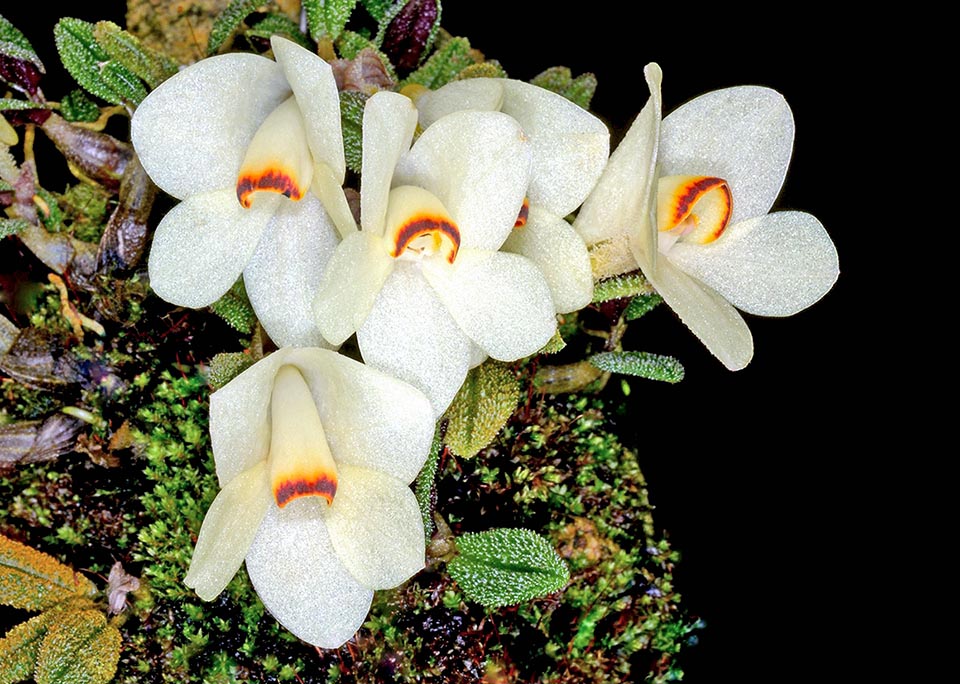
In some forms, varieties or hybrids stand pale cream yellow flowers fading to white after some weeks. Here they have maintained a red band on the margin of the labellum © Ron Parsons
The flowers, not resupinate, are 2,2-4 (5) cm long and 3,3 cm broad with a flexible peduncle that lays the flower down horizontally or renders it pendulous with the labellum facing upwards. The median sepal measures 10-21 x 3-12(-15) mm, oblong to widely elliptic, obtuse.
The lateral sepals measure 18-30(-34) x 4-12(-18) mm,,oblong to widely elliptic,at times widely triangular, with obtuse and rarely acute apex and with the basal part fused 4,5-8(-11) mm, strictly cylindrical; that forms a mentum (mentum) of 9-18 mm with obtuse tip. The petals measure 10-20 x (3,5-) 6-16 mm, obovate to round, obtuse. The labellum, when flattened, measures 12-30 x 5-15 mm, is obovate,adnate to the foot of the column, with very curved margins upwards and with the interior concave at times thickened and fleshy.
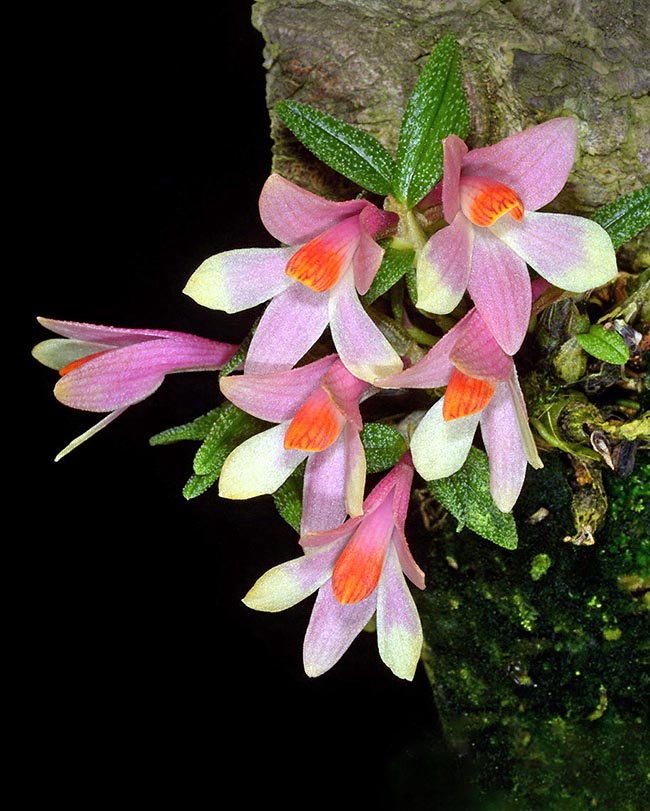
Sepals and petals may be of the same colour or bicolour, with clear apex or of a colour contrasting with the labellum © Ron Parsons
The flowers are red (scarlet to crimson), at times violet, pink, orange and less commonly yellow or white.
The red flowers predominate throughout the range, but in some places other variants of colour can be found.
Sepals and petals are of the same colour or are bicoloured, with the apical parts paler of colour contrasting with the labellum, sometimes paler, with reddish-brown specks, darker on the margin.
The column is 5-7 mm long and 5 wide. The foot is 9-18 mm long.
The anther measures 3,5 mm, with 2 mm long pollinodia.
The ovary has 6 ribs, densely or slightly papillose-hirsute, warty or glabrous.
The pedicel and the ovary are 10-32 mm long.
The fruit measures up to 20 x 10 mm, and is obliquely ellipsoidal with 6 longitudinal ribs.
This orchid blooms with a photoperiod varying, during the year, from 12 h 21 m’ to 11 h 39 m’ and a single flower will be able to last up to about 200 days (even more in cultivation).
Like many other species of orchids also Dendrobium cuthbertsonii has developed the strategy of the photosynthesis of the Crassulacean Acid Metabolism, called CAM.
This type of photosynthesis is an adaptation to the excessive water loss because the process of photosynthesis takes place with closed stomata that, conversely, open by night for the gaseous exchanges (CO2, O2) with minimal waste of water vapour.
The pollinators are not known but it is probable that it is pollinated by birds feeding on nectar like, for instance, the Black sunbird (Leptocoma aspasia, Nectariniidae) attracted by the flowers rich in nectar.
However, the flowers of Dendrobium cuthbertsonii do not produce nectar, it is therefore probable that the plant has produced bell-shaped flowers in order to imitate those that attract these birds.
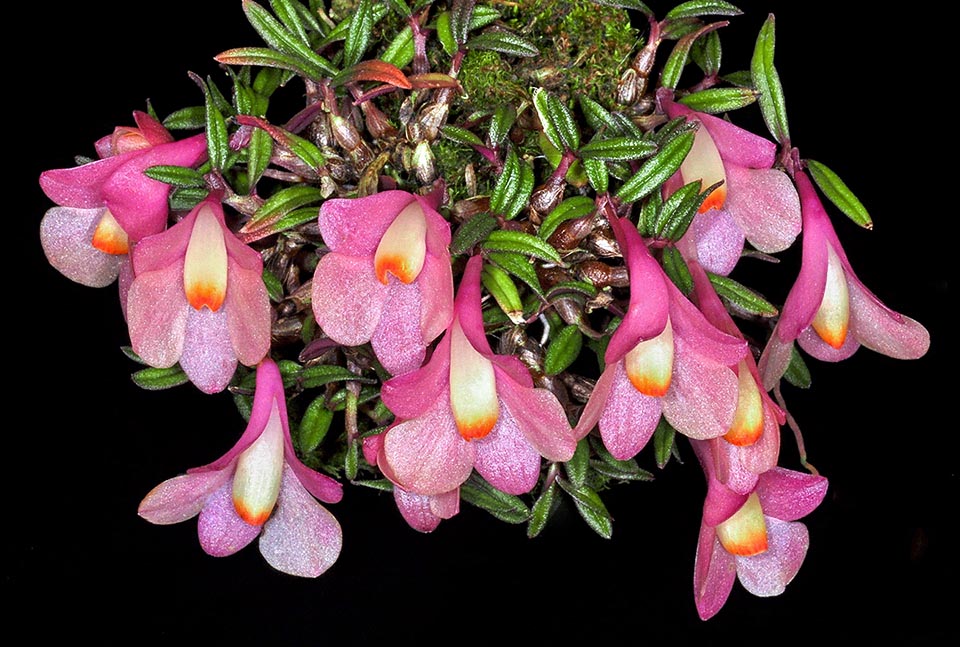
Besides the various natural colours of the flowers exist many cultivars through cross by the growers who have created bigger flowers and with new colours © Ron Parsons
As a matter of fact, several species of Rhododendron (Rhododendron sect. Vireya), present in the same habitat, have ornithophilous bell-shaped flowers and are variously coloured. In this way, shape and chromatic polymorphism of the flowers of Dendrobium cuthbertsonii, without any energy waste for the plant, fool the birds that accidentally carry out the pollination.
Dendrobium cuthbertsonii is a species protected from trade and as such is inserted in the Appendix II of Washington Convention (CITES) that has the aim of protecting the endangered animal and vegetable species, blocking their export and detention.
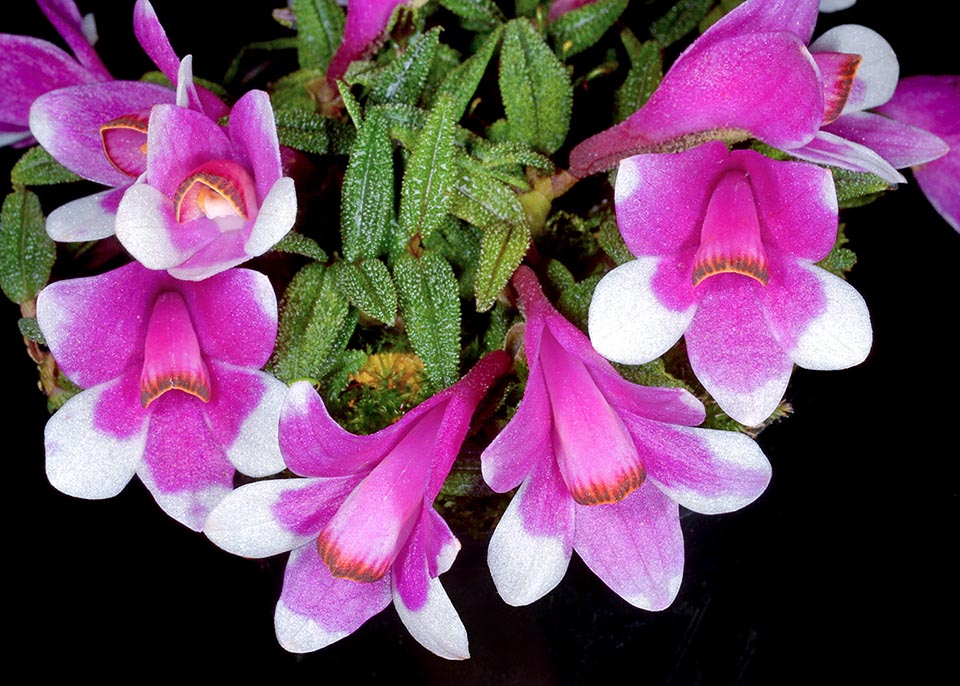
Bicolour variety with fuchsia sepals and petals, white at the tips. The labellum gets dark orange at the extremity © Ron Parsons
It’s a small plant with relatively big flowers and of various colours (from pure white pale yellow, orange and to red up to intense violet and bicoloured forms), this characteristic renders it a desirable plant for all enthusiasts.
We can say that, along with another species, also endemic to New Guinea, Dendrobium lawesii F.Muell., with similar chromatic variations, we have in front us the two only species of orchids in the world having the greatest number of different colours of their flowers.
Besides plants with flowers of various colours (red form, white form, green form, pink form), talented growers have created big flowers with new colours.
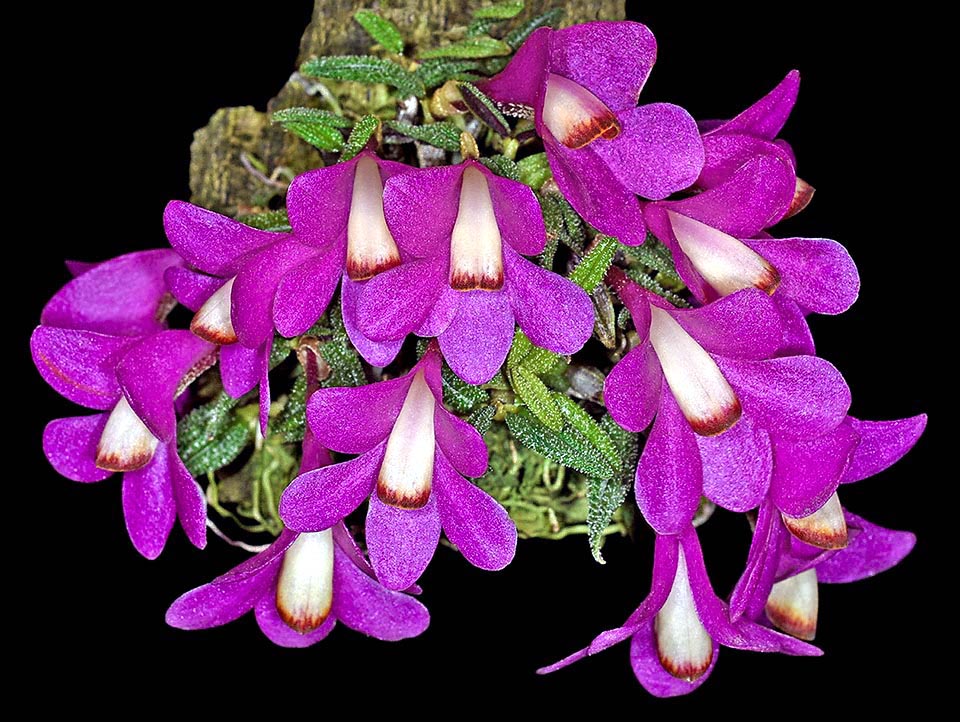
Here the fuchsia colour fades to violet. The very clear labellum is dark orange edged at the extremity © Ron Parsons
The use of colchicine, which is an antimitotic, has produced on the diploid plants, in the subsequent generations, followed by other crosses, flowers with significantly larger and more robust leaves than those of the wild plants. The tetraploid plants (4n) obtained in this way have flowers of excellent quality and long lasting.
The cross between Dendrobium cuthbertsonii, plant less than 3 m tall and Dendrobium pseudoglomeratum T.M.Reeve & J.J.Wood, much bigger plant, has originated the hybrid Dendrobium
Mountain Magic, Mountain Orch. 1996 that measures about 15 cm and has 4 cm long flowers. Furthermore, this hybrid, besides flowering several times a year, is more tolerant of the hot temperatures than its parent Dendrobium cuthbertsonii.
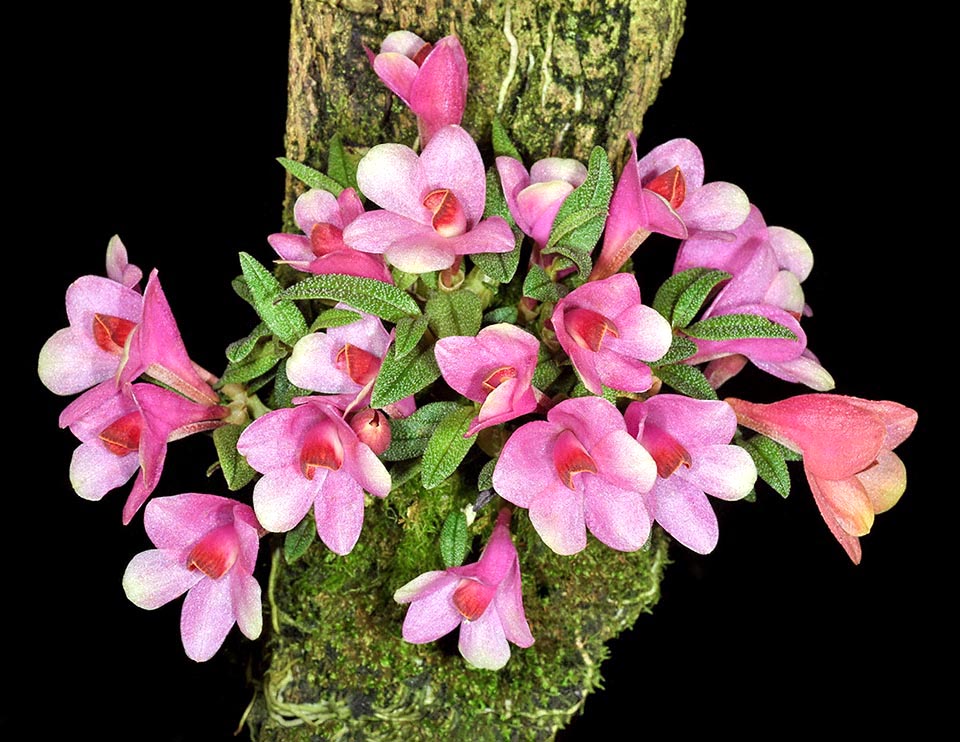
Here pink triumphs. Many cultivars of this species have received prestigious awards © Ron Parsons
Dendrobium glomeratum H.J.Veitch ex Rob. x Dendrobium cuthbertsonii is a primary hybrid very interesting due to the average dimensions of its plants, about 25 cm, that are relatively easy to cultivate and produce repeat-blooming flowers similar to those of Dendrobium cuthbertsonii.
The most recent selections have produced forms and dimensions of the flowers even bigger, more luminous and bicoloured. The latter ones have originated from the cross between Dendrobium cuthbertsonii ‘Lafayette’ with Dendrobium cuthbertsonii ‘Anna’, a cross that has originated exceptional flowers.
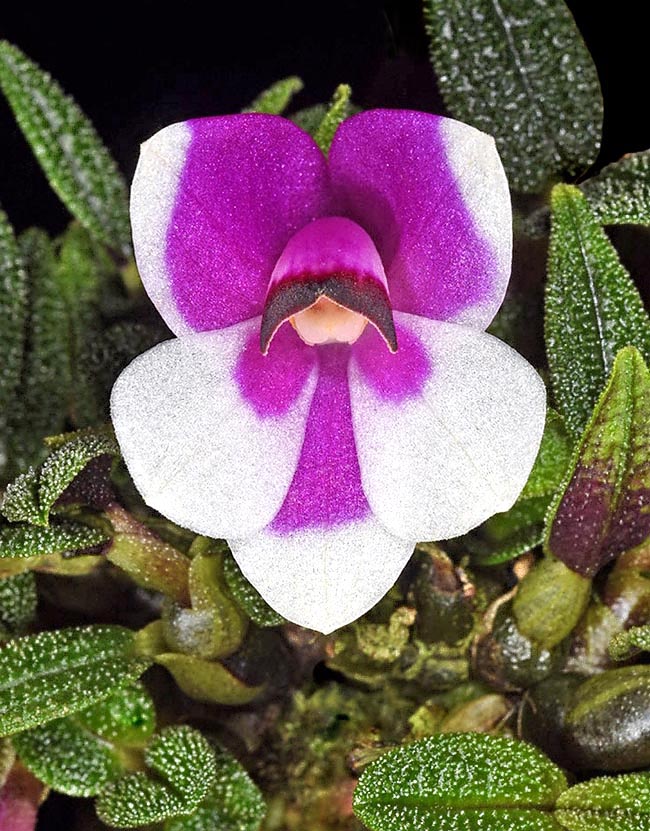
In this bicolour form strikes the unusual drawing in the combination of purple to white © Ron Parsons
The German Society of the Orchids (Deutsche Orchideen-Gesellschaft,DOG) has recently awarded the following cultivars: Dendrobium cuthbertsonii ‘Fasangarten’ (17 awards from 2010 to 2018); Dendrobium cuthbertsonii ‘Badefee’ (11 awards from 2010 to 2013); Dendrobium cuthbertsonii ‘Gruppe’ (8 awards from 2011 to 2018); Dendrobium cuthbertsonii ‘Drachenblut’ (7 awards from 2011 to 2016); Dendrobium cuthbertsonii ‘Alfons’ (7 awards from 2011 to 2014); Dendrobium cuthbertsonii ‘Schneewittchen 1’ (5 awards from 2017 to 2018); Dendrobium cuthbertsonii ‘Alexej’ (4 awards in 2014); Dendrobium cuthbertsonii ‘Neonblitz’ (3 awards in 2014); Dendrobium cuthbertsonii ‘Tina’ (3 awards from 2011 to 2012); Dendrobium cuthbertsonii ‘Donau crocus’ (2 awards in 2018); Dendrobium cuthbertsonii ‘Isa’ (2 awards in 2018); Dendrobium cuthbertsonii h.f. bicolor ‘Regina’ (2 awards in 2018); Dendrobium cuthbertsonii ‘Rotkäppchen 2’ (2 awards from 2017 to 2018); Dendrobium cuthbertsonii ‘Weiss-Rosa’ (2 awards in 2015); Dendrobium cuthbertsonii ‘Silbergrube’ (2 awards from 2012 to 2014).
The American Orchid Society (AOS) has awarded: Dendrobium cuthbertsonii ‘Christopher John’ (5 awards from 1985 to 2010); Dendrobium cuthbertsonii ‘Red Parrot’ (3 awards from 2001 to 2002).
The Australian Orchid Council Inc. (AOC) and The Orchid Societies Council of Victoria (OSCOV) have awarded: Maccraithea cuthbertsonii ‘Arcoona Park’ (3 awards in 2002).
The Orchid Council of New Zealand Inc. (ONZ) has awarded: Dendrobium cuthbertsonii ‘Louise’ (2 awards in 2015).
Dendrobium cuthbertsonii grows well on rafts or on stones, with a layer of live moss (sphagnum) under its roots. It can be cultivated in pots but it is good to utilize as substratum the sphagnum together with the perlite in a ratio of 1:1. The bark is to be avoided because there would be a risk of leaving the roots dry.
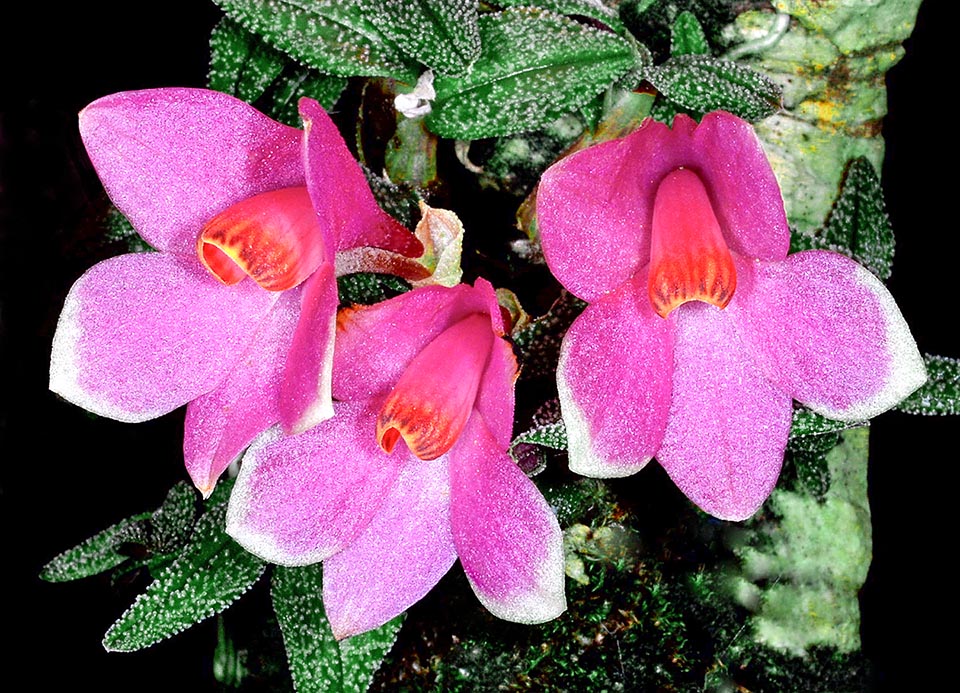
Only another species of New Guinea, Dendrobium lawesii, has similar amazing chromatic variations. They are the two orchids having the larger number of different colours © Ron Parsons
Drainage is essential, even if this plant requires a lot of humidity, but it is good to favour a flow of air for possible stagnation.
Being the roots very delicate, repotting must be avoided, as it is to be done only if necessary, like when the substratum is “old” or if the plant shows signs of rotting.
As this species grows in a mountain habitat, it does not tolerate the high temperatures typical of the tropical plain plants, therefore it must be kept in cool conditions (temperatures from 10 °C the night to 29 °C the day) with high humidity.
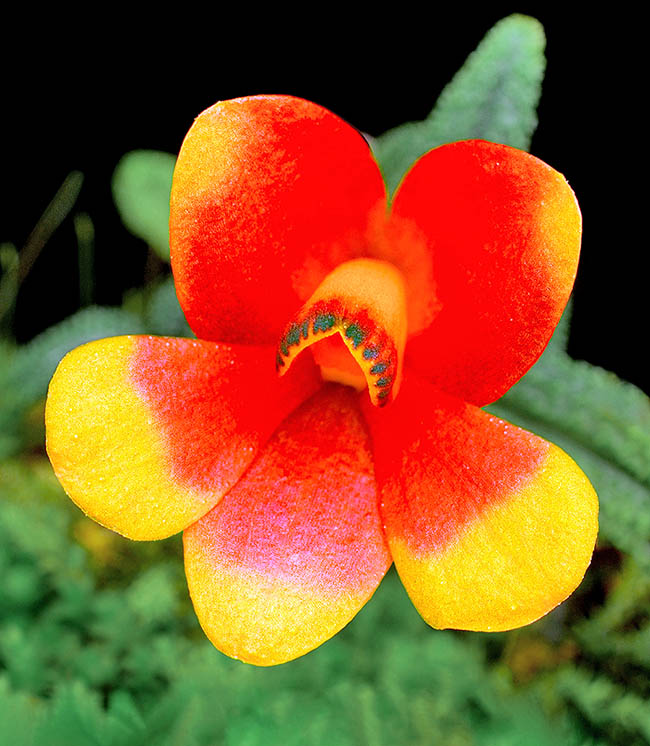
The cultivar ‘Bicolor Flare’ has bicoloured red and orange flowers that may last even 6 months. For a good growth of Dendrobium cuthbertsonii the environment must be cool with variable average temperatures © Eric Hunt
It is necessary, therefore, to irrigate often in order to avoid that the substratum dries up completely.
If cultivated with bare roots, it must be watered on a daily basis. Irrigation is necessary all year.
The fertilizations, with 1/4 the dosage shown on the small bottle of the liquid fertilizer for orchids, are to be done every 7-15 days.
During the winter months, the fertilizations are to be reduced, one every three-four weeks if the temperatures are mild.
Before fertilizing the plant, it is important to water its roots in order to avoid the detrimental effect of the fertilizer on the dry roots.
We can also do vaporizations on the leaves utilizing rainwater, deionized or obtained through reverse osmosis, but the tap water is never to be used, being this rich also in limestone.
If the night temperatures stand over the 10 °C and the day ones do not exceed the 24 °C, it can be kept in open air, in a position protected from the sun rays (from 8.000 – 10.000 lux) and the winds.
In these conditions there can be the night decrease of the temperatures necessary for the growth and the blooming.
If the minimum temperatures are higher (maximum allowable 16 °C) the orchid will grow more slowly and blooms will be less abundant.
The trend in nature of the populations of Dendrobium cuthbertsonii is not known and it appears in the IUCN Red List of the endangered species as “Least Concern“.
Synonyms: Dendrobium agathodaemonis J.J.Sm.; Dendrobium asperifolium J.J.Sm. Dendrobium atromarginatum J.J.Sm.; Dendrobium carstensziense J.J.Sm. nom. illeg.; Dendrobium coccinellum Ridl.; Pedilonum cuthbertsonii (F.Muell.) Brieger; Dendrobium euphues Ridl.; Dendrobium fulgidum Ridl. nom. illeg.; Dendrobium fulgidum var. purpureum Ridl.; Dendrobium laetum Schltr.; Dendrobium lichenicola J.J.Sm.; Dendrobium sophronites Schltr.; Dendrobium trachyphyllum Schltr.; Maccraithea agathodaemonis (J.J.Sm.) M.A.Clem. & D.L.Jones; Maccraithea asperifolia (J.J.Sm.) M.A.Clem. & D.L.Jones; Maccraithea atromarginata (J.J.Sm.) M.A.Clem. & D.L.Jones; Maccraithea coccinella (Ridl.) M.A.Clem. & D.L.Jones; Maccraithea cuthbertsonii (F.Muell.) M.A.Clem. & D.L.Jones; Maccraithea euphues (Ridl.) M.A.Clem. & D.L.Jones; Maccraithea lichenicola (J.J.Sm.) M.A.Clem. & D.L.Jones; Maccraithea sophronites (Schltr.) M.A.Clem. & D.L.Jones; Maccraithea trachyphylla (Schltr.) M.A.Clem. & D.L.Jones; Pedilonum asperifolium (J.J.Sm.) Brieger; Pedilonum coccinellum (Ridl.) Rauschert; Pedilonum euphues (Ridl.) Rauschert; Pedilonum sophronites (Schltr.) Rauschert; Pedilonum trachyphyllum (Schltr.) Brieger.
